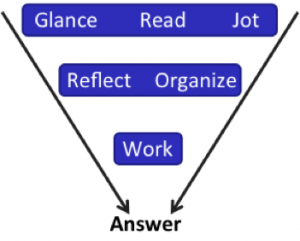-
Target Test Prep 20% Off Flash Sale is on! Code: FLASH20
Redeem
3 Steps to Better Geometry
 A couple of months ago, we talked about what to do when a geometry problem pops up on the screen.
A couple of months ago, we talked about what to do when a geometry problem pops up on the screen.
Do you remember the basic steps? Try to implement them on the below GMATPrep problem from the free tests.
* In the xy-plane, what is the y-intercept of line L?(1) The slope of line L is 3 times its y-intercept
(2) The x-intercept of line L is [pmath]-1/3[/pmath]
My title (3 Steps to Better Geometry) is doing double-duty. First, heres the general 3-step process for any quant problem, geometry included:
All geometry problems also have three standard strategies that fit into that process.
First, pick up your pen and start drawing! If they give you a diagram, redraw it on your scrap paper. If they dont (as in the above problem), draw yourself a diagram anyway. This is part of your Glance-Read-Jot step.
Second, identify the wanted element and mark this element on your diagram. Youll do this as part of the Glance-Read-Jot step, but do it last so that it leads you into the Reflect-Organize stage. Where am I trying to go? How can I get there?
Third, start Working! Infer from the given information. Geometry on the GMAT can be a bit like the proofs that we learned to do in high school. Youre given a couple of pieces of info to start and you have to figure out the 4 or 5 steps that will get you over to the answer, or what youre trying to prove.
Lets dive into this problem. Theyre talking about a coordinate plane, so you know the first step: draw a coordinate plane on your scrap paper. The question indicates that theres a line L, but you dont know anything else about it, so you cant actually draw it. You do know, though, that they want to know the y-intercept. What does that mean?
They want to know where line L crosses the y-axis. What are the possibilities?
Infinite, really. The line could slant up or down or it could be horizontal. In any of those cases, it could cross anywhere. In fact, the line could even be vertical, in which case it would either be right on the y-axis or it wouldnt cross the y-axis at all. Hmm.
Make some kind of symbol on your diagram to indicate that you want to know where the line crosses the x-axis. On my diagram, I drew a big arrow pointing straight down to the top of the y-axis line.
Okay, whats next? Ah, the statements! What can you infer from the first one?
(1) The slope of line L is 3 times its y-intercept
Its tough to put this one on the diagramhow would you draw it? This is actually a really big clue for you.
Your whole goal is to try to figure out whether theres just one way to draw the line or more than one. Because this is data sufficiency, try to disprove the statement: that is, try to find more than one y-intercept that is acceptable. If so, then the statement is not sufficient.
Lets see. Say the y-intercept is 1. Then the slope would be 3. Is that allowed? Sure! The problem doesn't set any limits for the value of the slope.
What if the y-intercept is 2? Then the slope would be 6. Is that allowed? Yep, for the same reason as above.
Boom. Thats two possible values for the y-intercept, so the statement is insufficient. Eliminate answers (A) and (D) and move on to the second statement.
(2) The x-intercept of line L is [pmath]-1/3[/pmath]
Cool, a concrete piece of information. Put it on your diagram. Okay, now where could the y-intercept be?
Oh. Anywhere! Theres no information at all about the rest of the line, including the y-intercept. Not sufficient! Cross off answer (B).
Okay, here comes the tricky part: put the two statements together.
(1) The slope of line L is 3 times its y-intercept(2) The x-intercept of line L is [pmath]-1/3[/pmath]
Quick! Whats your initial instinct, right now? If you had to guess immediately, without thinking about this at all, would you guess that these two piece of info will answer the question or that they wont?
In my experience, most people will think that they do. In fact, before I actually worked through the problem myself, it did sort of seem like the two statements would work together. After all, youve got one point (the x-intercept) as well as info about the slope. Shouldnt that be enough? Is there really more than one way to draw that line?
Heres the thing: I was immediately wary of that impression because I've learned through (painful!) experience that, on data sufficiency, when something feels a certain way the opposite answer is often true. So lets dig in.
Many people, if not most, will try to combine the two pieces of info algebraically. I thought of two ways to do this.
First, translate statement one into an equation. Call the slope m and the y-intercept b. The equation is m = 3b. Substitute that equation into the standard slope-intercept equation y = mx + b:
y = (3b)x + b
You have one true point, the x-intercept: ([pmath]-1/3[/pmath], 0). Plug the point in and see what you get for b:
0 = (3b)([pmath]-1/3[/pmath]) + b
0 = -b + b
0 = 0
Huh. Thats funny. If you really know your math, then youll know what this outcome means: b could be anything. Most people, though, figure that they made a mistake somewhere or that this isnt a valid way to solve.
So maybe they try this next:
[pmath]slope={rise/run}={y_2-y_1}/{x_2-x_1}[/pmath]
We have two points: ([pmath]-1/3[/pmath], 0) and (0, b) where b is the y-intercept:
[pmath]{b-0}/{0-(-1/3)}=b/{1/3}=3b[/pmath]
Hmm, so the slope equals 3bwait a second! This statement is just saying that m = 3b. Thats what statement one says by itself and you already decided thats not sufficient.
Again, many people will assume they made a mistake here, but the real answer is that youre getting this result because there are infinite possibilities for the y-intercept.
How are you going to prove that to yourself? Fall back to the try some real numbers technique that youve already been using.
So, the x-intercept is [pmath]-1/3[/pmath]. Look at your coordinate plane. Pick a value for the y-intercept. How about 1? Okay, if the y-intercept is 1, then the slope is:
[pmath]{1-0}/{0-(-1/3)}=1/{1/3}=3[/pmath]
Does that fit the equation from statement 1? Yep, the slope is 3 times bigger than the y-intercept.
What if you make the y-intercept 2? Then, the slope is:
[pmath]{2-0}/{0-(-1/3)}=2/{1/3}=6[/pmath]
Check it out. The slope, 6, is once again 3 times bigger than the y-intercept, 2. There are at least two possibilities, so youre done.
The correct answer is (E).
Key Takeaways for Better Geometry
(1) Draw! This is key for any geometry problem. There are too many moving parts; you need to keep track of everything in a clear way.
(2) On Data Sufficiency, you can try to prove the statements mathematically but unless geometry is your favorite subject, you may drive yourself a little nuts. If the problem lends itself to what we call Testing Cases (testing numbers to find different possibilities, as we did above), then go for it!
(3) Start using your 3 steps for geometry: Draw. ID the wanted element. Infer.
* GMATPrep questions courtesy of the Graduate Management Admissions Council. Usage of this question does not imply endorsement by GMAC.
Recent Articles
Archive
- April 2024
- March 2024
- February 2024
- January 2024
- December 2023
- November 2023
- October 2023
- September 2023
- July 2023
- June 2023
- May 2023
- April 2023
- March 2023
- February 2023
- January 2023
- December 2022
- November 2022
- October 2022
- September 2022
- August 2022
- July 2022
- June 2022
- May 2022
- April 2022
- March 2022
- February 2022
- January 2022
- December 2021
- November 2021
- October 2021
- September 2021
- August 2021
- July 2021
- June 2021
- May 2021
- April 2021
- March 2021
- February 2021
- January 2021
- December 2020
- November 2020
- October 2020
- September 2020
- August 2020
- July 2020
- June 2020
- May 2020
- April 2020
- March 2020
- February 2020
- January 2020
- December 2019
- November 2019
- October 2019
- September 2019
- August 2019
- July 2019
- June 2019
- May 2019
- April 2019
- March 2019
- February 2019
- January 2019
- December 2018
- November 2018
- October 2018
- September 2018
- August 2018
- July 2018
- June 2018
- May 2018
- April 2018
- March 2018
- February 2018
- January 2018
- December 2017
- November 2017
- October 2017
- September 2017
- August 2017
- July 2017
- June 2017
- May 2017
- April 2017
- March 2017
- February 2017
- January 2017
- December 2016
- November 2016
- October 2016
- September 2016
- August 2016
- July 2016
- June 2016
- May 2016
- April 2016
- March 2016
- February 2016
- January 2016
- December 2015
- November 2015
- October 2015
- September 2015
- August 2015
- July 2015
- June 2015
- May 2015
- April 2015
- March 2015
- February 2015
- January 2015
- December 2014
- November 2014
- October 2014
- September 2014
- August 2014
- July 2014
- June 2014
- May 2014
- April 2014
- March 2014
- February 2014
- January 2014
- December 2013
- November 2013
- October 2013
- September 2013
- August 2013
- July 2013
- June 2013
- May 2013
- April 2013
- March 2013
- February 2013
- January 2013
- December 2012
- November 2012
- October 2012
- September 2012
- August 2012
- July 2012
- June 2012
- May 2012
- April 2012
- March 2012
- February 2012
- January 2012
- December 2011
- November 2011
- October 2011
- September 2011
- August 2011
- July 2011
- June 2011
- May 2011
- April 2011
- March 2011
- February 2011
- January 2011
- December 2010
- November 2010
- October 2010
- September 2010
- August 2010
- July 2010
- June 2010
- May 2010
- April 2010
- March 2010
- February 2010
- January 2010
- December 2009
- November 2009
- October 2009
- September 2009
- August 2009
